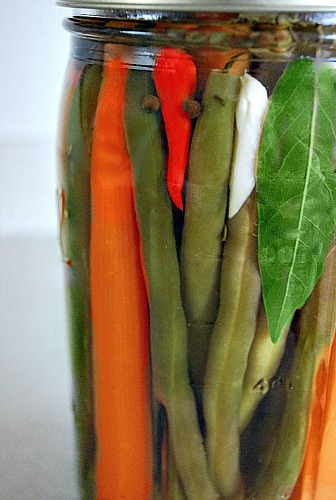
What is it about that colorful city called New Orleans that gets under my skin? I've visited many times, and each time, I fall in love with NOLA all over again.
For me, New Orleans is an irresistible combination of live music, phenomenal food and rich culture, all set in a place so photogenic that the only time I set my camera down is when I need both hands to eat a Po' Boy sandwich.
As if I needed one more reason to visit New Orleans, my youngest son is moving there in a few short days. He'll be joining my middle son, who attends Loyola University.
When I miss a place or a person, I tend to do what other cooks do...I head to the kitchen and get busy. This morning I started putting together spices that remind me of Louisiana, like cayenne pepper, celery seeds, black peppercorns, and a clove or two of garlic, and before I knew it I was on my way to a batch of Cajun-style Pickled Green Beans & Carrots; a jar full of flavors reminiscent of the South.
For one quart jar of pickled veggies, start with a total of 1-1/2 pounds green beans and carrots. I prefer very thin organic baby carrots for this, purchased with their greens still attached so I know they're fresh & sweet.
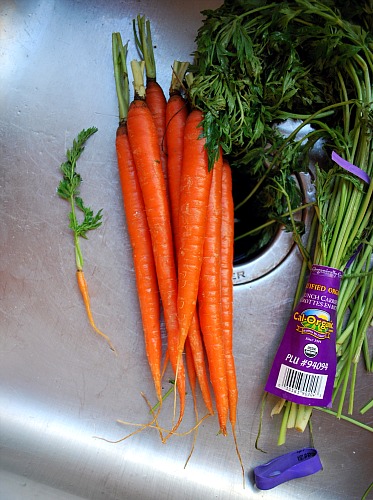
You can use more of one or the other -- green beans of carrots -- if you'd like, or just do all carrots or all beans.
Wash them, and trim them to fit the jar. I like to use a pair of kitchen scissors to trim the stem end off the green beans.
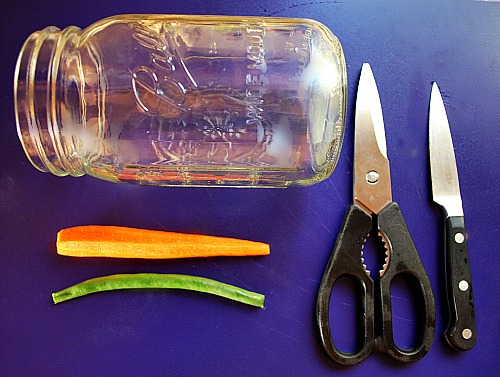
Be sure the carrots and/or beans aren't sticking above the shoulder of the jar. You need space for other things, like garlic, spices and brine, and you don't want the veggies to touch the sealing lid either.
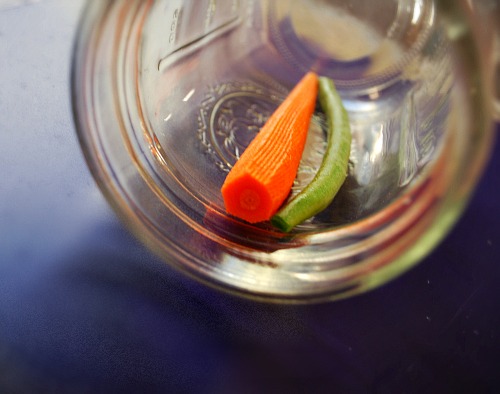
Pack the jar as full as you possibly can.
The veggies will shrink a tad bit during processing.
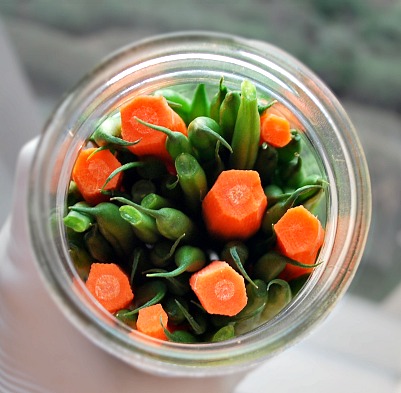
See how pretty the jar looks once its full of veggies?

Make a brine by adding together in a sauce pan:
1 cup white vinegar
1/2 cup water
1 teaspoon white sugar
1 teaspoon pickling or kosher salt
Heat to boiling, stirring to dissolve the sugar and salt, then immediately remove pan from heat once the sugar and salt are no longer visible. Set brine aside to cool.
~~~~~~~~~
Add directly to the jar:
1 bay leaf
1 or 2 cloves of garlic
6 black peppercorns
1/2 teaspoon celery seeds
1/2 teaspoon yellow mustard seeds
1/4 teaspoon cayenne pepper
1/4 teaspoon dried thyme
1 dried Arbol chile, if you have it
Note: it helps to use a chopstick to tuck the bay leaf, garlic and Arbol pepper - if using - along the side of the jar.
~~~~~
Pour brine over the vegetables.
Wipe the rim of the jar if needed, and place a sealing lid atop the jar. Next, screw a ring onto the jar finger-tight and process in a boiling water bath for 10 minutes. Once properly sealed, the pickles will keep for one year on the shelf. You can also skip the processing step and store the pickled veggies in your refrigerator, but they won't have the same flavor since the processing adds to the way the veggies soak up the brine.
For now, keeping myself busy by cooking will have to do, but I'm already checking SEA to MSY airfare, and the musical line-up for the spring 2012 New Orleans Jazz & Heritage Festival.
Have pickles, will travel.
